Toyota Avalon (2018 year). Instruction - part 16

241
4-5. Using the driving support systems
4
Drivin
g
The Blind Spot Monitor function uses radar sensors to detect vehicles
that are traveling in an adjacent lane in the area that is not reflected in
the outside rear view mirror (the blind spot), and advises the driver of
the vehicles existence via the outside rear view mirror indicator.
WARNING
■
Handling the radar sensor
One Blind Spot Monitor sensor is installed inside the left and right side of
the vehicle rear bumper respectively. Observe the following to ensure the
Blind Spot Monitor system can function correctly.
●
Do not subject the sensor or surrounding area on the bumper to a strong
impact. If the sensor moves even slightly off position, the system may mal-
function and vehicles that enter the detection area may not be detected. If
the sensor or surrounding area is subject to a strong impact, always have
the area inspected by your Toyota dealer.
●
Do not disassemble the sensor.
●
Do not attach accessories or stickers to the sensor or surrounding area on
the bumper.
●
Do not modify the sensor or surrounding area on the bumper.
●
Do not paint the rear bumper any color other than an official Toyota color.
The Blind Spot Monitor function
●
Keep the sensor and its surrounding
area on the bumper clean at all times.